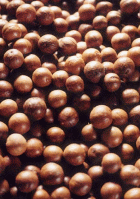 SKC Films Library |
| SKC Films Library >> Fruit and Fruit Culture |
| Macadamia Nut a large, round seed that grows on a tropical evergreen native to Australia
The macadamia has a hard, smooth shell that must be cracked by a special machine. The white kernel is often roasted in oil and then eaten as is, but can also be used in cakes, candies, and other baked goods. Today, Hawaii is the largest producer of macadamia nuts in the world, followed by Australia. The nut is also grown commercially in South Africa, Kenya, Guatemala, and Brazil, but in far lesser quantities. California is the only state in the Continental United States in which macadamias are grown commercially. The Tree The macadamia tree belongs to the family Proteaceae. It grows up to 60 feet in height, and has a spread of up to 40 feet. The leaves are glossy and dark green in color. There are two principal species, Macadamia integrifolia (smooth-shell) and Macadamia tetraphylla (rough-shell), with the smooth-shell variety being the most popular with commercial growers.
The leaves of the smooth-shell variety grow up to 12 inches long, in whorls of three, and are usually free of spines. The flowers are creamy white in color and grow in axillary racemes up to 12 inches long consisting of several hundred flowers. The rough-shell variety has leaves of up to 20 inches in length, with spines along their entire length. The pink or creamy white flowers grow in whorls of four. The fruit consists of a fleshy husk enclosing a spherical seed 1/2- to 1/4-inch in diameter. A macadamia tree usually begins producing fruit about six to seven years after planting, and may continue producing for up to 60 years or more. An average tree will produce from 60 to 150 pounds of nuts annually. Macadamia trees can self-pollinate, but bees are the principal pollinating agents in the wild. Cultivation, Harvest, and Nut Preparation Macadamia trees grow best in a mild, frost-free, subtropical climate. Although somewhat drought tolerant, best nut quality is achieved when the region receives at least 50 inches of general rainfall per year. Although macadamias can be planted from seed, they are most commonly grafted. This is because it can take up to 12 years for a seedling tree to bear fruit if planted, but a grafted seedling may begin bearing fruit in as little as two or three years. Ripe macadamia nuts are "harvested" only after they have fallen to the ground. In Hawaii, harvest usually begins in May and runs through to December. Once gathered, the nuts are run through special machines to remove the husks and then allowed to dry for about two weeks. Once dry, more special machinery is used to remove the kernel from the shell, after which the kernels are cleaned, sorted, and then processed for retail sale. Although macadamias can be purchased still in the shell, the average consumer will opt to pay extra for already-shelled nuts because the macadamia happens to have one of the hardest shells of all nuts and conventional nut crackers will often break long before the shell does. Kernels can be eaten raw, roasted, or in a variety of confectionary and baked goods. History The macadamia has been part of the food supply of Australian aborigines since ancient times, but there is no evidence that they ever cultivated the trees. It was first domesticated in Australia in 1858, and the first commercial orchard was established in Australia about 1888. It is still the only native Australian plant ever developed into a commercial food crop. Macadamia seedlings were introduced into Hawaii by William Herbert Purvis in 1882, who planted them at Kukuihaele, on the island of Hawaii. SOURCES SEE ALSO |
| SKC Films Library >> Fruit and Fruit Culture This page was last updated on 06/17/2018. |

